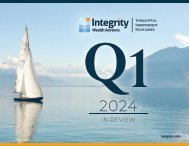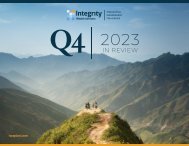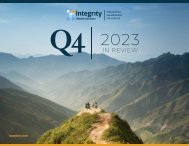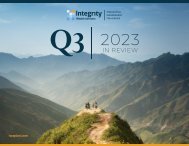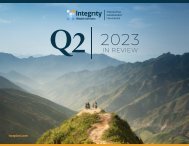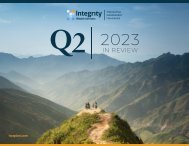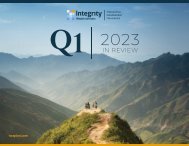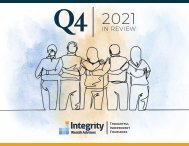You also want an ePaper? Increase the reach of your titles
YUMPU automatically turns print PDFs into web optimized ePapers that Google loves.
<strong>Q4</strong><br />
<strong>2022</strong><br />
IN REVIEW
TOTAL RETURN <strong>2022</strong> <strong>Q4</strong> + NEWSWORTHY EVENTS<br />
October 7 – The U.S.<br />
Department of Labor<br />
reported that nonfarm<br />
payrolls for the month<br />
of September increased<br />
by 263,000, versus<br />
economists’ consensus<br />
expectation of 275,000<br />
October 27 – The first<br />
estimate of U.S. GDP for Q3<br />
shows an acceleration at<br />
a pace of 2.6%, better than<br />
expected as growth turns<br />
positive<br />
October 28 – Elon<br />
Musk completes his<br />
$44 billion acquisition<br />
of Twitter<br />
November 2 – The<br />
Federal Reserve raises<br />
interest rates by 0.75%<br />
November 11 – The<br />
cryptocurrency<br />
exchange FTX, once<br />
valued at $18 billion,<br />
files for bankruptcy in<br />
a collapse that affects<br />
the cryptocurrency<br />
environment<br />
December 2 – The G7 and<br />
Australia join the EU in<br />
imposing a cap of $60 a<br />
barrel on Russian crude oil,<br />
designed to "prevent Russia<br />
from profiting from its war of<br />
aggression against Ukraine"<br />
December 14 – The Federal<br />
Reserve raises interest<br />
rates by 0.50%, to the<br />
highest level in 15 years<br />
December 18 – Argentina<br />
wins the <strong>2022</strong> FIFA World<br />
Cup that is held in Qatar<br />
December 21-26 – A major winter<br />
storm hits the northern United States<br />
and southern Canada. Killing at least<br />
91 people, the storm also severely<br />
disrupts North American air traffic, with<br />
Southwest Airlines alone canceling<br />
more than half of its schedule<br />
18.0%<br />
S&P 500 TOTAL RETURN<br />
MSCI ACWI EX USA TOTAL RETURN<br />
BARCLAYS US AGGREGATE TOTAL RETURN<br />
16.6%<br />
15.2%<br />
13.8%<br />
14.37%<br />
12.4%<br />
11.0%<br />
9.6%<br />
8.2%<br />
6.8%<br />
7.56%<br />
5.4%<br />
4.0%<br />
2.6%<br />
1.2%<br />
1.87%<br />
-0.2%<br />
-1.6%<br />
-3.0%<br />
October<br />
November<br />
December<br />
As of close 12/30/<strong>2022</strong><br />
12%<br />
S&P 500 TOTAL RETURN<br />
MSCI ACWI EX USA TOTAL RETURN<br />
BARCLAYS US AGGREGATE TOTAL RETURN<br />
Source: https://en.wikipedia.org/wiki/<strong>2022</strong><br />
11%<br />
10.42%
THE FIGHT AGAINST INFLATION<br />
<strong>2022</strong><br />
<strong>Q4</strong><br />
IN REVIEW<br />
Two Thousand and Twenty-Two was a historic year for the financial markets<br />
and, unfortunately, not in a good way. With the worst stock market since 2008<br />
and the worst bond market in the 45 years that Bloomberg has been tracking it,<br />
international markets fared no better.<br />
What caused the disruption? We feel the main culprit was the Federal Reserve's<br />
fight against inflation. <strong>In</strong> the last quarter of 2021, the Federal Reserve declared<br />
inflation to be "transitory" and said they would be unlikely to raise rates by more<br />
than "two or three 25 basis point hikes." <strong>In</strong>stead, they increased rates to the<br />
equivalent of seventeen 25 basis point hikes. These were historic actions on the<br />
part of the Federal Reserve; never have they raised rates by 75 basis points four<br />
meetings in a row. Consequentially, we are now at a rate we have not seen in<br />
fifteen years.<br />
The higher interest rate environment has slowed the residential real estate<br />
market to a grinding halt; the same loan costs you 45% more per month than it<br />
did exactly one year ago. It also served to crash the bond market. To illustrate,<br />
imagine that you had invested $100,000 in a 20-year treasury bond at the<br />
beginning of 2021. You'd have ended <strong>2022</strong> with just $68,000 dollars. This<br />
equates to a 32% loss - something you would never expect from investing in the<br />
"safer" bond market. The broader US Aggregate Bond index dove 13% in <strong>2022</strong><br />
alone. With stocks also down, there was nowhere to hide save cash, and even<br />
then, you were still losing out to inflation.<br />
Where do we go from here? With market pessimism as high as it is, it feels like<br />
a replay of 2008, when the market was down some 38%. The following year saw<br />
a significant rebound, rising 27% by year's end, but only after losing 25% in the<br />
first two months of the year. A positive sign is the so-called "put/call ratio," which<br />
enters 2023 at 2-1, meaning there are two investors for every one investor who<br />
thinks the market is going down. That's considered a bullish sign for the market.<br />
History also suggests the market will finish with an up year. Remember, last year<br />
was a mid-term election year, and every mid-term election year for the past 70<br />
years saw a stock market gain twelve months after election day. There are other<br />
historical precedents we could list, but the above two are powerful in our view<br />
and leave us optimistic for a positive ending to 2023.<br />
ECONOMIC CHARTS & NOTES<br />
CONSUMER SENTIMENT Easing inflationary pressures softened Americans'<br />
negative views in <strong>Q4</strong>, but the sentiment remains downbeat compared to a year ago.<br />
Retail sales fell from October to November ahead of the holiday shopping season.<br />
EMPLOYMENT Job additions blew past expectations despite the Fed's<br />
efforts to slow the labor market. The unemployment rate ticked back up to<br />
3.7%, as anticipated.<br />
US Retail Sales<br />
Consumer Sentiment<br />
Unemployment Rate<br />
NonFarm Payroll<br />
34%<br />
100<br />
16%<br />
2200<br />
US Retail Sales % Chg<br />
28%<br />
22%<br />
16%<br />
10%<br />
4%<br />
-2%<br />
-8%<br />
90<br />
80<br />
70<br />
60<br />
Consumer Sentiment<br />
Unemployment Rate %<br />
14%<br />
12%<br />
10%<br />
8%<br />
6%<br />
4%<br />
-825<br />
-3850<br />
-6875<br />
-9900<br />
-12925<br />
-15950<br />
-18975<br />
NonFarm Payroll<br />
-14%<br />
Jan '19<br />
Jul '19<br />
Jan '20<br />
Jul '20<br />
Jan '21<br />
Jul '21<br />
Jan '22<br />
Jul '22<br />
50<br />
2%<br />
Jan ' 19<br />
Jul '19<br />
Jan '20<br />
Jul '20<br />
Jan '21<br />
Jul '21<br />
Jan '22<br />
Jul '22<br />
-22000<br />
Source: University of Michigan Consumer Sentiment. Retail Sales - U.S. Census Bureau.<br />
Source: U.S. Bureau of Labor Statistics
ECONOMIC CHARTS & NOTES<br />
CONSUMER PRICE INDEX Led by lower gasoline, prices rose less than<br />
expected in November, sparking a stock market rally. <strong>In</strong>flation cooled for the<br />
5th straight month, offering consumers some much needed relief.<br />
Y/Y % Chg<br />
8%<br />
7%<br />
6%<br />
5%<br />
4%<br />
3%<br />
2%<br />
1%<br />
CPI Less Food<br />
CPI All<br />
0%<br />
2018 2019 2020 2021<br />
Source: U.S. Bureau of Labor Statistics<br />
<strong>2022</strong><br />
CONSUMER SPENDING Disposable income stayed below 2021 levels,<br />
absent stimulus checks and pent-up demand. Personal spending increased as<br />
lower prices for gas, smartphones, and T.V.s enabled consumers to find room for<br />
other purchases.<br />
% Chg Year-over-year<br />
30<br />
25<br />
20<br />
15<br />
10<br />
5<br />
0<br />
-5<br />
-10<br />
-15<br />
-20<br />
-25<br />
Jan '19<br />
Jul '19<br />
Consumption<br />
Jan '20<br />
Jul ' 20<br />
Jan '21<br />
Disposable <strong>In</strong>come<br />
Jul '21<br />
Source: U.S. Bureau of Economic Analysis<br />
Jan '22<br />
Jul '22<br />
JOB OPENINGS & HIRES Retail jobs growth was light ahead of the holiday<br />
shopping as stores took a cautious stance. The health care and social services<br />
sector posted strong job gains in <strong>Q4</strong>.<br />
GDP U.S. GDP returned to growth in Q3, lifted by a narrower trade deficit and higher<br />
consumer and government spending. Despite a resilient labor market and improving<br />
confidence, many economists are braced for a recession heading into 2023.<br />
Retail Openings<br />
Retail Hires<br />
GDP<br />
Amount in Thousands<br />
1500<br />
1200<br />
900<br />
600<br />
300<br />
0<br />
Jan '18<br />
Jul '18<br />
Jan '19<br />
Jul '19<br />
Jan '20<br />
Jul '20<br />
Jan '21<br />
Jul '21<br />
Jan '22 Jul '22<br />
% Growth<br />
40%<br />
35%<br />
30%<br />
25%<br />
20%<br />
15%<br />
10%<br />
5%<br />
0%<br />
-5%<br />
-10%<br />
-15%<br />
-20%<br />
-25%<br />
-30%<br />
Q1 Q2 Q3 <strong>Q4</strong> Q1 Q2 Q3 <strong>Q4</strong> Q1 Q2 Q3 <strong>Q4</strong> Q1 Q2 Q3 <strong>Q4</strong> Q1 Q2 Q3 <strong>Q4</strong><br />
2017<br />
2018 2019 2020 2021<br />
Q1<br />
Q2<br />
Q3<br />
<strong>2022</strong><br />
Source: U.S. Bureau of Labor Statistics<br />
Source: U.S. Bureau of Economic Analysis
LEI AND S&P DOWNTURN<br />
<strong>2022</strong><br />
<strong>Q4</strong><br />
IN REVIEW<br />
Although we think a recession<br />
is likely in 2023, we don’t<br />
expect the downturn to be<br />
deep or prolonged. Remember,<br />
historically the stock market<br />
bottoms midway through a<br />
recession.<br />
We think inflation will<br />
moderate as the economy<br />
contracts. However, we do<br />
expect the CPI to settle in<br />
above pre-pandemic levels,<br />
so it may be appropriate to<br />
maintain inflation protection.<br />
One benefit of higher interest<br />
rates is that bond investors<br />
can finally expect higher<br />
yields from their fixed-income<br />
portfolios. Adding to holdings<br />
in higher quality investment<br />
grade bonds is one effective<br />
way to take advantage of more<br />
attractive yield potential.<br />
Source: Conference Board, NBER, Refinitv; Latest data point Nov <strong>2022</strong><br />
LEADING ECONOMIC<br />
INDICATORS<br />
Conference Board LEI<br />
year-over-year percent<br />
change, recessions are<br />
shaded<br />
We’re entering a period when<br />
economic news or central<br />
bank activity could trigger<br />
further volatility. Also, as<br />
we were reminded in <strong>2022</strong>,<br />
unexpected geopolitical<br />
events could arise, with<br />
impacts that ripple into the<br />
capital markets.<br />
Maintain your discipline when<br />
emotions are running high and<br />
make decisions based<br />
on a carefully considered<br />
investment strategy that’s<br />
aligned with your long-term<br />
goals.<br />
S&P INTRA-YEAR<br />
DECLINES VS.<br />
CALENDAR YEAR<br />
RETURNS<br />
Despite average intrayear<br />
drops of 14.0%,<br />
annual returns were<br />
positive in 32 of 42 years<br />
Source: FactSet, Standard & Poor's, J.P. Morgan. Returns are based on price index only and do not include dividends. <strong>In</strong>tra-year drops refers to the largest market drops from<br />
a peak to a trough during the year. For illustrative purposes only. Returns shown are calendar year returns from 1980 to 2021, over which time period the average annual<br />
return was 9.4%. U.S. Data are as of December 31, <strong>2022</strong>.
ARE OIL AND OIL EQUITIES MOVING HIGHER FOR 2023?<br />
The crude oil industry is not new to supply disruptions<br />
and price volatility. Over the past seven years,<br />
the industry has seen several peaks and troughs,<br />
from above $140/bbl in 2008 to -$37/bbl in 2020.<br />
But the situation is unique today. A confluence of<br />
several economic, geopolitical, trade, policy, and<br />
financial factors have exacerbated the issue of<br />
underinvestment and triggered a readjustment in<br />
the broader energy market. The industry is trying<br />
to achieve a balance between energy security and<br />
diversification of supply, while making<br />
a low-carbon transition. Environmental<br />
concerns as well as the political pressure<br />
put on energy producers has led to reduced<br />
capital expenditures, and this contributed<br />
to the tight markets seen in <strong>2022</strong>.<br />
Meanwhile, the disruption of energy trade<br />
between Europe and Russia has driven<br />
global gas markets to new highs in <strong>2022</strong>,<br />
with European prices reaching six to ten<br />
times US Henry Hub prices. Furthermore,<br />
the shortage of agricultural products<br />
for renewable fuels and supply chain<br />
challenges for low-carbon technologies<br />
have impacted the progress of energy<br />
transition. Although the immediate impact<br />
of this imbalance is high energy prices and<br />
record cash flows for O&G companies, the<br />
industry’s investment trajectory in 2023 will likely be<br />
determined by many of the actions and decisions<br />
being taken today. To get a feel for the markets, let’s<br />
look at the current supply and demand conditions in<br />
the oil industry.<br />
First let’s consider oil demand. The most important<br />
near-term catalyst for oil is the lifting of covid<br />
lockdowns in China, which continue to persist. The<br />
resumption of Chinese economic and industrial<br />
activity, as well as incremental travel, implies 2-3<br />
million barrels per day (MM bbl/d) of oil demand just<br />
to recover to 2019 pre-covid levels. And this doesn’t<br />
account for the longer-term demand growth trend,<br />
or “catch up” demand, from over a billion people<br />
locked down for several years. Some analysts are<br />
forecasting that that Chinese de-confinement could<br />
add up to 3.3MM bbl/d of oil demand, more demand<br />
growth than the rest of the world combined, and jolt<br />
prices higher.<br />
Meanwhile, the U.S. has released nearly 180MM<br />
barrels of crude oil from the Strategic Petroleum<br />
Reserve (SPR) to lower gasoline prices for<br />
consumers. U.S. commercial & SPR oil inventories<br />
are now at levels not seen since the mid 1980’s, as is<br />
illustrated in the graph below.<br />
Now let’s consider oil supply. Oil supply is strained<br />
both in OPEC+ and non-OPEC countries. OPEC+ is<br />
nearly out of spare capacity. <strong>In</strong> aggregate, OPEC+<br />
has repeatedly missed its quotas for more than 2<br />
years now—even after a 2MM bbl/d cut—and total<br />
OPEC+ production levels may be topping out for now.<br />
<strong>In</strong> consideration of these quota misses and lower<br />
global oil prices, OPEC+ may be incentivized to cut<br />
production further, a move which could reverse the<br />
negative momentum in oil prices entirely on its own,<br />
absent a significant global economic downturn. Even<br />
if OPEC+ maintains its production quota, it is likely<br />
it will continue to struggle to meet it, which may<br />
result in a 3.9MM bbl/d market shortfall from pre-cut<br />
expectations. Furthermore, sanctions against Russia<br />
are intensifying, which may curb its oil output in 2023.<br />
<strong>In</strong>surance bans on Russian tankers carrying crude for<br />
EU firms, a price cap of $60/bbl on Russian oil, and<br />
outright bans on Russian crude imports to Europe<br />
have already come into effect, affecting more than<br />
two-thirds of Russian oil exports to the EU. These may<br />
lead to declining exports for Russia despite some<br />
willing buyers in Asia. Reportedly, Russian crude<br />
exports fell by 0.5MM bbl/d in December, and with<br />
limited means to get its oil to market, analysts predict<br />
Russian output is likely to fall by 1.4MM bbl/d in<br />
2023. North American oil production is also struggling<br />
to grow. Years of underinvestment<br />
in oil exploration, development, and<br />
infrastructure, driven by anti-fossil fuel<br />
policy and shifting investor preferences,<br />
have contributed to production growth<br />
below consensus expectations. This is<br />
aided by persistent labor shortages, as<br />
well as shortages in drilling rigs and other<br />
oil field equipment critical to production.<br />
This combined with the depletion of<br />
the best wells may result in U.S. shale<br />
production struggling to exceed prior<br />
highs.<br />
Historically, the change in U.S. oil<br />
inventories has been a leading indicator<br />
of oil prices. While SPR releases have<br />
had a modest impact on gasoline prices,<br />
they may ironically lead to much higher prices in the<br />
future, as there is much less oil in reserve to address<br />
actual emergencies or supply disruptions. Oil prices<br />
at the beginning of 2023 are still moving downward,<br />
as the release from the SPR appears to be coming<br />
to an end, yet the fundamental setup of lower supply<br />
and increased demand is making investment in<br />
the oil market even more attractive. Supply is tight,<br />
demand is improving, and China appears to be rapidly<br />
re-opening. This presents investors with another<br />
compelling opportunity to face into the negative<br />
sentiment around buying oil & gas equities, especially<br />
because of the equities of heavily discounted small<br />
cap oil and gas producers as well as oilfield services<br />
companies, despite the significant overall volatility<br />
that likely lies ahead. The timing in 2023 seems<br />
appropriate for investment in the oil industry.
THE COLLAPSE OF FTX<br />
<strong>2022</strong><br />
<strong>Q4</strong><br />
IN REVIEW<br />
FTX, one of the largest cryptocurrency exchanges in the world,<br />
collapsed in just ten days. Sam Bankman-Fried, the former CEO of FTX,<br />
whose fortune rose to $26.5 billion last year, was arrested in the Bahamas and<br />
charged with defrauding investors on multiple counts.<br />
It all started on November 2nd, when an article from a crypto news site, CoinDesk,<br />
revealed that Alameda Research, the crypto trading firm also run by Bankman-<br />
Fried, held a position valued at $5 billion in FTT, a digital currency created by<br />
FTX. This prompted concern across the industry regarding Bankman-Fried's<br />
undisclosed leverage and solvency.<br />
What occurred next was a virtual bank run. On November 6th, Binance, the world's<br />
biggest crypto exchange, announced that it would sell its entire position in FTT<br />
tokens, valued at about $529 million. The price of FTT dropped sharply. By the<br />
next day, FTX was experiencing a liquidity crisis. As the price dropped, many FTX<br />
customers moved to withdraw their assets from the platform.<br />
Though the extent of the connections between Alameda and FTX were not yet<br />
public, a series of recent crypto platform collapses had already put the crypto<br />
community on edge. Customers demanded withdrawals worth $6 billion in<br />
the days immediately following the CoinDesk report. Bankman-Fried searched<br />
for additional money from venture capitalists before turning to rival Binance.<br />
The value of FTT fell by more than 80% in two days, and FTX stopped allowing<br />
customers to take money out of the platform.<br />
What was not yet public was the extent of the connections between Alameda<br />
and FTX or just how bad things had gotten for Bankman-Fried's companies.<br />
Those connections became more apparent in the days following FTX's move to<br />
stop withdrawals, as did their financial challenges. The Wall Street Journal and<br />
CNBC, citing anonymous sources, reported that Alameda had used FTX funds for<br />
trading. <strong>In</strong> an interview on Vox, Bankman-Fried confirmed reports that funds had<br />
moved between FTX and Alameda, adding that he "thought Alameda had enough<br />
collateral" to cover the moves. Soon after, blockchain analysts tracked the flow<br />
of $400 million of assets out of FTX accounts, though it was unclear why those<br />
funds had been moved. <strong>In</strong> a series of text messages to Reuters, Bankman-Fried<br />
denied funds had been furtively funneled from one company to the other. He<br />
blamed the transfers on an internal mislabeling issue.<br />
On November 11th, Bankman-Fried stepped down as CEO of FTX and was<br />
replaced by a court-appointed CEO, John J. Ray III. The same day, FTX filed<br />
for Chapter 11 bankruptcy. Within hours of filing, FTX said it was the victim of<br />
"unauthorized transactions" and would move its digital assets to cold storage for<br />
security purposes.<br />
Bahamian authorities arrested Bankman-Fried on December 12th, <strong>2022</strong>. U.S.<br />
Attorney Damian Williams said when announcing the charges against the former<br />
CEO that it was one of the largest financial crimes in American history. New FTX<br />
CEO Ray told the U.S. House committee on December 13th that FTX practiced "no<br />
bookkeeping." He added: "It was old-fashioned embezzlement."<br />
Bankman-Fried is set to face trial on eight criminal charges on October 2, 2023.<br />
After a court hearing on December 22nd, a federal judge decided to release<br />
Bankman-Fried from custody after his attorneys and federal prosecutors agreed<br />
to a $250 million bond, the largest ever. He will live with his parents in Palo Alto,<br />
<strong>California</strong>, be confined to the Northern <strong>California</strong> area, and wear an electronic<br />
monitoring bracelet. On January 3rd, 2023, Bankman-Fried pleaded not guilty to<br />
all criminal charges in a federal court in New York.<br />
The future of FTX as a cryptocurrency exchange is in serious jeopardy. As of mid-<br />
November <strong>2022</strong>, withdrawals were disabled, and a notice on the FTX website says<br />
the company "strongly advise[s] against depositing."<br />
The broader consequences of the FTX fiasco for the cryptocurrency industry<br />
will take time to unfold. As the most significant collapse in the short history of<br />
cryptocurrencies, FTX may further deter investors, who are already cautious<br />
because of concerns about stability and security. Customers on the FTX<br />
platform may not recover their assets, potentially triggering legal action. The<br />
U.S. Securities and Exchange Commission (SEC) and other regulators may<br />
see the collapse of FTX as justification for tightening regulatory scrutiny of<br />
cryptocurrencies. Congress may be more inclined to step in and create new laws<br />
governing digital tokens and exchanges.<br />
The stunning collapse of the third-largest crypto exchange by volume will send<br />
shock waves through the crypto universe for some time. To date, other large<br />
crypto platforms have seen withdrawals of customer funds increase, and some<br />
have even paused withdrawals. This story is unfolding, the lasting effects of the<br />
collapse of FTX have yet to be seen, and the future of Sam Bankman-Fried is<br />
highly uncertain.<br />
Source: Forbes.com; investopedia.com
INVESTMENT<br />
MANAGEMENT<br />
PHILOSOPHY<br />
The complex, ever-changing investment world of today<br />
requires an investment process that is overseen by a team<br />
of experienced investment professionals. Global capital<br />
markets present investors with a host of challenges due to<br />
the combination of an overwhelming amount of information<br />
to analyze and the endless supply of conflicting opinions and<br />
narratives surrounding financial markets. The time and expertise<br />
required to perform in-depth investment research and to make<br />
timely and informed portfolio management decisions requires<br />
both a clear investment process and an experienced investment<br />
team to implement the process.<br />
An old adage states that there is accomplishment through<br />
many advisors. We agree and embrace a variety of investment<br />
perspectives through our investment committee. Our investment<br />
philosophy is well grounded in global macro-economic analysis.<br />
<strong>In</strong>vestment ideas are carefully vetted through a process which<br />
incorporates the diverse range of investment backgrounds<br />
within our firm. This process of multifaceted analysis ensures<br />
that only the strongest investment ideas survive. We are<br />
committed to striking the right balance between risk and<br />
return through managing global, multi-asset class investment<br />
portfolios.<br />
INDEPENDENCE &<br />
CLIENT FOCUS<br />
DIVERSIFICATION<br />
TOP-DOWN, THEMATIC<br />
APPROACH<br />
PERFORMANCE WITH<br />
LIQUIDITY<br />
VARIED INVESTMENT<br />
PERSPECTIVES<br />
OPTIMIZATION OF<br />
EXPENSES AND TAXES<br />
THE INVESTMENT PROCESS<br />
ASSESSMENT OF GLOBAL<br />
ECONOMIC & INVESTMENT<br />
ENVIRONMENT<br />
ASSESS & ANALYZE<br />
THEMES<br />
RESEARCH INVESTMENT<br />
VEHICLES TO FIND<br />
EFFECTIVE IMPLEMENTATION<br />
IDENTIFY<br />
OPPORTUNITIES<br />
STRATEGIC ASSET<br />
ALLOCATION -<br />
Geographies, Sectors,<br />
Capitalizations<br />
INVESTMENT SELECTION -<br />
Open/Closed End Funds, ETFs, Stocks & Bonds
INVESTMENT COMMITTEE<br />
<strong>2022</strong><br />
<strong>Q4</strong><br />
IN REVIEW<br />
The <strong>In</strong>vestment Committee meets formally<br />
each quarter, and more frequently if market<br />
conditions warrant, to discuss the state of<br />
the global economy and capital markets and<br />
to assess the current asset allocation and<br />
positioning of our portfolios. There’s an art<br />
to striking the right balance between risk and<br />
return; pursuing that symmetry is the core of<br />
our investment philosophy. We are fiduciaries<br />
and have our interests aligned with our<br />
clients, as we invest alongside them.Contact<br />
us at investmentcommittee@iwaplan.com<br />
with any questions or concerns.<br />
STEPHEN WAGNER<br />
CEO, <strong>In</strong>vestment Advisor,<br />
CFP ® , CPFA<br />
35+ Years Experience*<br />
VICTORIA BREEN<br />
<strong>In</strong>vestment Advisor &<br />
Financial Planner<br />
40+ Years Experience*<br />
MARTHA LAFF<br />
<strong>In</strong>vestment Advisor,<br />
ChFC ® , CLU ® , CRPC ®<br />
30+ Years Experience*<br />
ANDREW MURTHA<br />
Financial Analyst,<br />
MBA<br />
20+ Years Experience*<br />
BOB CHEATHAM<br />
Financial Planner,<br />
CRPS®, MA<br />
MARGARET MARAPAO<br />
<strong>In</strong>vestment Advisor &<br />
Financial Planner, CFP ®<br />
CHRISTOPHER WAGNER<br />
<strong>In</strong>vestment Advisor &<br />
Financial Planner, CPFA<br />
LAINE MILLER<br />
<strong>In</strong>vestment Advisor &<br />
Financial Planner, CFP ®<br />
DOUG ECKER<br />
<strong>In</strong>vestment Advisor &<br />
Financial Planner, CRPS®<br />
15+ Years Experience*<br />
* Financial services experience. <strong>In</strong>vestment Advisory Services are offered through investment advisor representatives of <strong>In</strong>tegrity <strong>Wealth</strong> <strong>Advisors</strong>, a Federally Registered <strong>In</strong>vestment Advisor.<br />
Victoria Breen, Bob Cheatham, Doug Ecker, Laine Miller and Christopher Wagner are solely investment advisor representatives of <strong>In</strong>tegrity <strong>Wealth</strong> <strong>Advisors</strong>. LLC. and not affiliated with LPL Financial.<br />
THOUGHTFUL<br />
INDEPENDENT<br />
FIDUCIARIES<br />
<strong>In</strong>tegrity <strong>Wealth</strong> <strong>Advisors</strong> has<br />
been committed to helping<br />
individuals, families, and<br />
businesses grow, preserve, and<br />
distribute wealth since 1979<br />
VENTURA<br />
196 S Fir St, Ste 140<br />
<strong>Ventura</strong>, CA 93001<br />
(805) 339-0760<br />
ventura@iwaplan.com<br />
OJAI<br />
205 S Signal St,<br />
<strong>Ojai</strong>, CA 93023<br />
(805) 646-3729<br />
ojai@iwaplan.com
THE IMPACT OF<br />
SOUND FINANCIAL<br />
PLANNING<br />
Recent Vanguard research 1 shows that an experienced<br />
wealth management team not only adds peace of mind,<br />
but also may add about 3 percentage points of value in<br />
net portfolio returns over time. What does this mean? Your<br />
team has the ability and the time to evaluate your portfolio<br />
investments, meet with you to discuss objectives, and<br />
help get you through tough markets. All of these factored<br />
together potentially add value to your net returns (returns<br />
after taxes and fees) over time. But the most interesting part<br />
of this research is that it shows that financial planning and<br />
financial coaching contributed to the greater majority of the<br />
added net 3% in net portfolio returns.<br />
It’s important to realize how valuable making sound financial<br />
planning decisions is and that value is added by your<br />
financial planning team. As investors, our emotions can be<br />
our worst enemy, especially when the markets are volatile,<br />
and guidance from a “behavioral coach” can save us from<br />
panic-selling and abandoning long-term financial plans.<br />
Numerous studies demonstrate that advisors can have a<br />
huge impact on investor finances, but it’s hard to say if these<br />
findings have been recognized and understood by everyday<br />
investors.<br />
DREAM.<br />
PLAN.<br />
ENJOY.<br />
GUARANTEED INCOME<br />
With interest rates the highest they have been in over a decade, guaranteed, fixed income<br />
products are becoming attractive again. High Yield Savings Accounts, Certificates of<br />
Deposit, and Fixed Annuities have recently become a great investment vehicle for your<br />
emergency funds or for longer term assets if you are nervous to invest in the stock or<br />
bond markets.<br />
High Yield Savings Account (HYSA)<br />
A. A high yield savings account (HYSA) is an online bank account that offers a much<br />
higher yield interest rate than traditional banks.<br />
B. These HYSAs work in a similar way as a normal bank - you log in to the account via<br />
their website, can see your money, can deposit money, etc.<br />
C. Be sure to check the fees and required initial deposit before your open an account.<br />
You will also want to find out how easy it will be to transfer funds from your normal<br />
bank account.<br />
D. Your money cannot lose value, HYSA’s are FDIC <strong>In</strong>sured.<br />
E. The interest rate** you receive on a HYSA today may be different from the interest<br />
rate you’ll receive next year or even next month. These interest rates are determined<br />
by the Federal Reserve and are constantly changing. At the time of writing, interest<br />
rates as high as 4.10% were obtainable*.<br />
Certificate of Deposit (CD)<br />
A. A CD is a savings account that holds a fixed amount of money for a fixed period of<br />
time, such as six months, one year or five years; in exchange, the issuing bank pays<br />
interest.<br />
B. CDs are FDIC insured and therefore cannot lose value providing you leave the CD for<br />
its entire term.<br />
C. Brokered CDs can be purchased in brokerage accounts and can be sold on a<br />
secondary market. However, if interest rates have risen, you may have to sell your CD<br />
on the secondary market for a discount. Alternatively, if interest rates fall, you could<br />
sell at a premium.<br />
D. Bank CDs can be purchased from banks and cannot be sold on the secondary<br />
market. You can liquidate early by sacrificing a few months of interest as a penalty.<br />
E. CDs are best if you feel you can wait until the term ends when your principal will be<br />
returned in full.<br />
F. As of writing, you can obtain a 12 month CD with an interest rate as high as 4.50%*.<br />
Fixed Annuity<br />
A. A fixed annuity is an insurance contract that guarantees the buyer a fixed rate of<br />
return on their contributions for a specific period of time.<br />
B. There is generally a surrender schedule associated with these products that reduces<br />
liquidity. However, there are some new products becoming available that do not have<br />
a surrender schedule.<br />
C. <strong>In</strong>terest earned on fixed annuities are tax deferred. Annuities are meant for<br />
retirement and there can be a 10% penalty on earnings if distributed before age 59.5.<br />
D. As of writing, interest on a 12 month fixed annuity is around 4.75%*.<br />
*Yields are quoted as of 01/05/2023 and are subject to change based on market conditions.<br />
**Guarantees are based on the claims-paying ability of the issuing insurance company.
SECURE ACT 2.0<br />
<strong>In</strong> the last couple weeks of <strong>2022</strong>, the Senate and the House passed the Consolidated Appropriations Act 2023, and President Biden signed the bill into law. A Section of the bill<br />
known as the Secure Act 2.0 of <strong>2022</strong> has some changes that affect retirement accounts. We wanted to summarize the highlights of the bill that will most likely affect you:<br />
REQUIRED MINIMUM DISTRIBUTION (RMD)<br />
Effective on January 1, 2023, the RMD age has been raised<br />
for some individuals based on the following criteria:<br />
a. Born in 1950 or earlier: RMD begins at age 72<br />
b. Born between 1951-1959: RMD begins at age 73<br />
c. Born in 1960 or later: RMD begins at age 75<br />
ROTH PROVISIONS<br />
a. For taxable years beginning after the date of enactment, plan participants may choose whether<br />
matching contributions to a defined contribution plan are considered Roth (after-tax basis).<br />
b. For taxable years after December 31, 2023, SEP and SIMPLE IRA plans may be designated as<br />
Roth IRAs.<br />
QUALIFIED CHARITABLE DISTRIBUTION (QCD)<br />
INDEXED FOR INFLATION<br />
Beginning in 2024, the maximum annual QCD of $100,000 will be adjusted for inflation.<br />
Please note that the age for Qualified Charitable Distributions is still 70 ½.<br />
EXPANSION OF AUTOMATIC ENROLLMENT IN<br />
RETIREMENT PLANS<br />
Effective for plan years beginning after December 31, 2024, qualified<br />
401(k), 403(b) and defined contribution plans will have a requirement<br />
to add an automatic enrollment to their plan at a pre-tax level of not<br />
less than 3% and not more than 10%.<br />
INCREASE IN CREDIT FOR SETTING<br />
UP RETIREMENT PLANS<br />
For taxable years starting after December 31,<br />
<strong>2022</strong>, the Act modifies the three year small<br />
business startup credit for plan administrative<br />
costs from 50% of plan expenses to 100% with<br />
a maximum credit of $5,000.<br />
ROTH 401(K) RMD<br />
Beginning in 2024,<br />
RMDs are no longer<br />
required from Roth 401(k)<br />
accounts. RMDs are still<br />
required from Roth 401(k)<br />
accounts in 2023.<br />
TREATMENT OF STUDENT LOAN REPAYMENTS AS<br />
ELECTIVE DEFERRALS FOR PURPOSES OF MATCHING<br />
CONTRIBUTION<br />
For plan years beginning after December 31, 2023, an employer can make<br />
matching contributions under a 401(k) plan or 403(b) plan, or SIMPLE IRA<br />
plan for student loan payments up to the maximum deferral amounts.<br />
401(K) / SIMPLE IRA CATCH-UP CONTRIBUTIONS<br />
Starting in 2025, some individuals can increase their employer-sponsored<br />
retirement plan catch-up contributions.<br />
a. 401(k): <strong>In</strong>dividuals whose age is 60-63 in 2025 and later will see their catchup<br />
contribution limit increased to a greater of $10,000 or 150% of the regular<br />
catch-up contribution amount.<br />
b. SIMPLE IRA: <strong>In</strong>dividuals whose age is 60-63 in 2025 and later will see their<br />
catch-up contribution limit increased to a greater of $5,000 or 150% of the<br />
regular catch-up contribution amount.<br />
Source: House.gov
VENTURA<br />
196 S Fir St, Ste 140<br />
<strong>Ventura</strong>, CA 93001<br />
(805) 339-0760<br />
ventura@iwaplan.com<br />
OJAI<br />
205 S Signal St,<br />
<strong>Ojai</strong>, CA 93023<br />
(805) 646-3729<br />
ojai@iwaplan.com<br />
The S&P 500 <strong>In</strong>dex or the Standard & Poor's 500 <strong>In</strong>dex is a market-capitalization-weighted index of the 500 largest U.S. publicly traded companies. The S&P 500 is<br />
a float-weighted index, meaning company market capitalizations are adjusted by the number of shares available for public trading. <strong>In</strong>vestors cannot invest directly<br />
in an index. Note: <strong>In</strong>vestors cannot invest directly in an index. These unmanaged indices do not reflect management fees and transaction costs that are associated<br />
with most investments.<br />
The MSCI World ex USA <strong>In</strong>dex captures large and mid cap representation across 22 of 23 Developed Markets (DM) countries* – excluding the United States. With<br />
1,012 constituents, the index covers approximately 85% of the free float-adjusted market capitalization in each country.<br />
The Barclays Capital U.S. Aggregate Bond <strong>In</strong>dex is the most common index used to track the performance of investment grade bonds in the U.S.<br />
The opinions expressed in this program are for general informational purposes only and are not intended to provide specific advice or recommendations for any<br />
individual or on any specific security. It is only intended to provide education about the financial industry. To determine which investments may be appropriate for<br />
you, consult your financial advisor prior to investing. Any past performance discussed during this program is no guarantee of future results. Any indices referenced<br />
for comparison are unmanaged and cannot be invested into directly. <strong>In</strong>vesting involves risk and possible loss of principal capital; please seek advice from a licensed<br />
professional.<br />
Vanguard research study; Source: Francis M. Kinniry Jr., Colleen M. Jaconetti, Michael A. DiJoseph, and Yan Zilbering, 2014. Putting a value on your value: Quantifying<br />
Vanguard Advisor’s Alpha. Valley Forge, Pa.: The Vanguard Group.<br />
There is no guarantee that a diversified portfolio will enhance overall returns or outperform a non-diversified portfolio. Diversification does not protect against market<br />
risk. Dollar cost averaging involves continuous investment in securities regardless of fluctuation in price levels of such securities. An investor should consider their<br />
ability to continue purchasing through fluctuating price levels. Such a plan does not assure a profit and does not protect against loss in declining markets.<br />
<strong>In</strong>tegrity <strong>Wealth</strong> <strong>Advisors</strong> is a registered investment adviser. Advisory services are only offered to clients or prospective clients where <strong>In</strong>tegrity <strong>Wealth</strong> <strong>Advisors</strong> and<br />
its representatives are properly licensed or exempt from licensure. No advice may be rendered by <strong>In</strong>tegrity <strong>Wealth</strong> <strong>Advisors</strong> unless a client service agreement is in<br />
place.<br />
Advisory services offered through <strong>In</strong>tegrity <strong>Wealth</strong> <strong>Advisors</strong> (IWA), a registered investment advisor. Certain, but not all, investment advisor representatives (IARs) of<br />
IWA are also registered representatives of, and offer securities through LPL Financial, member FINRA/SIPC. IWA and LPL Financial are separate entities.




